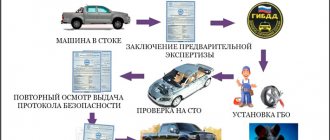“Platon” is an automated payment system for using roads, which has been operating in the Russian Federation since 2015. Vehicle identification occurs automatically. Using a transponder installed in the vehicle, a special assigned identification code is transmitted to a roadside reader. It is a microprocessor-based two-way radio (RFID) operating in the 900 MHz radio frequency range using dedicated short-range communication (DSRC) protocols.
The transponder contains basic information, including identification number, toll services, vehicle type, etc.
The secondary objective of the Platon system is to increase road capacity by introducing tolling on open roads.
Open Road Tolling (ORT) is the collection of tolls solely by electronic means.
The system allows you to make payments directly while the car is moving, which allows you not to delay the movement and make the process almost invisible to the driver and not distract him directly from driving.
ORT is a technological solution that allows you to make payments without stopping the vehicle.
Vehicle identification occurs in two ways:
- Using a transponder installed inside;
- by video image of the license plate.
Although using such a payment system can reduce costs by automating the payment process, on the other hand, a lot of money is required to process image-based data and conduct transactions.
How does the Plato system work in 2021?
What is the Plato system today? What innovations await drivers in 2021?
It’s worth starting with the basic tariff of 1 ruble 90 kopecks per kilometer. System participants are given two payment methods to choose from:
- Route map;
- Using an on-board device.
The route map contains the route of the planned trip, it indicates the starting and ending points, as well as the date of departure of the vehicle. It is possible to additionally specify from 1 to 10 intermediate points. You can apply for a route card yourself through your personal account on the Platon system website or through the mobile application. If you encounter any difficulties with the registration, you can contact the User Information Support Center. Payment for the trip must be made within 24 hours from the moment the card is issued. This can be done in the following ways:
1In the mobile application or personal account.
2In the Customer Information Support Center.
3Through Internet banking, Qiwi e-wallet, Sberbank Online, as well as in Qiwi and Sberbank terminals (but with a commission).
The on-board unit is more suitable for carriers that operate regular flights. For them, preparing a route map turns out to be too expensive due to the time required.
The on-board unit is provided on a free-of-charge basis upon conclusion of the appropriate contract for installation and is subsequently assigned to a specific vehicle. When using it, it is important not to forget that the Platon system requires pre-payment for the trip, so you need to monitor the balance of your account so that it is enough for the entire trip route.
If the funds in the account are not enough to automatically pay for the fare, a fine of 5,000 rubles for the first violation and 10,000 rubles for a second violation will be imposed on the driver and owner of the vehicle.
To avoid a fine, you can set up notifications in your personal account when a certain balance is reached. There is also the possibility of deferred payment. To receive a deferment, the system user must meet a number of conditions:
1Be a resident of the Russian Federation.
2Be registered in the Platon system for more than 2 months.
3Have an on-board unit.
4Do not have unpaid fines or overdue debt for driving on federal roads.
It is also impossible not to note the changes that are planned or have already occurred in 2021. Let's start with the fact that on January 1, 2021, the tax preference within which truckers had the right to a reduction in transport tax depending on the amount paid through the Platon system ceased to apply. Another unpleasant news may be the plans of the Russian government to increase the tariff, scheduled for July 1, 2021 due to the expiration of the moratorium on its indexation.
How it works
Now let's talk about the issue of payment, how this system works and what the relatively new project means for heavy truck drivers. Also in the future you will learn where to go, how to use it and whether it is possible to deceive Plato.
see also
High-quality body polishing with your own hands at home
It is unlikely that the government expected that drivers would voluntarily pay for the damage they cause to roads by driving heavy-duty vehicles along the highways. After all, when traveling 12 tons, irregularities and depressions are formed, gradually turning into holes. And they need to be repaired, undergo constant reconstruction and build something new. Therefore, it was decided to create the most reliable system with effective payment control. Plato works extremely simply. The system receives information about the vehicle and calculates the payment amount depending on what kind of car it is and how far it has traveled along the federal highway.
As the developers intended, all heavy trucks will be equipped with special programmed devices. This on-board device is called BU 1201. The movement is monitored by GLONASS systems and the ubiquitous GSM. Moreover, the systems work in conjunction, which ensures increased accuracy.
There is a special stationary frame on the track. It is she who controls the movement of cars. There are also special stores there that have the necessary equipment for payment.
Initially, about 100 frames were installed throughout the country. But in the future their number should increase 5 times, and maybe more. Approximately 100 vehicles, which are also equipped with monitoring and tracking devices, regularly change their location. This is about the question of whether Plato can be deceived. This is unlikely to succeed. Although many try, some, they claim, have even succeeded. You can visit the thematic forum and read about it there. And if you have personal experience with the Plato system, be sure to write in the comments, tell us the nuances that you know, or just interesting stories.
And we will move on and consider several more important issues related to Plato.
What laws govern the operation of the Plato system?
The operation of the Platon system is regulated by a number of regulations and documents developed by the government of the Russian Federation since 2005:
- Transport strategy of the Russian Federation for the period until 2020;
- Federal Law No. 257-FZ dated November 8, 2007 (as amended on December 27, 2018) “On highways and road activities in the Russian Federation”;
- Decree of the Government of the Russian Federation of November 17, 2010 No. 928;
- Decree of the Government of the Russian Federation No. 1191 as amended on June 28, 2018 (fee amount and coefficient);
- transport strategy of the Russian Federation for the period until 2030;
- Federal Law of 06.04. 2011 No. 68-FZ (as amended on December 14, 2015);
- Order of the Government of the Russian Federation dated August 29, 2014 No. 1662-r;
- Decree of the Government of the Russian Federation of May 18, 2015 No. 474.
In addition to the above documents, there are acts directly regulating the entire life cycle and operation of this system:
- Decree of the Government of the Russian Federation of June 14, 2013 N 504 (as amended by Decrees of the Government of the Russian Federation of 05/18/2015 N 474, of 03/11/2015 N 1191, of 15/04/2016 N 310, of 14/11/2016 N 1182, of 20/06/201 7 N 731, as amended by Resolution of the Constitutional Court of the Russian Federation dated May 31, 2016 N 14-P;
- Decree of the Government of the Russian Federation dated December 26, 2016 No. 1483;
- Federal Law No. 257-FZ dated November 8, 2007 (as amended on December 27, 2018) “On highways and road activities in the Russian Federation”;
- Decree of the Government of the Russian Federation of November 17, 2010 No. 928;
- Federal Law of December 14, 2015 No. 378-FZ;
- Decree of the Government of the Russian Federation No. 1191 as amended on June 28, 2018 (fee amount and coefficient);
- Decree of the Government of the Russian Federation of May 18, 2015 No. 474;
- Decree of the Government of the Russian Federation of March 24, 2021 No. 330;
- Decree of the Government of the Russian Federation of November 14, 2021 No. 1182;
- Federal Law of 06.04. 2011 No. 68-FZ (as amended on December 14, 2015);
- Order of the Government of the Russian Federation dated August 29, 2014 No. 1662-r;
- Decree of the Government of the Russian Federation dated April 15, 2016 No. 310;
- Decree of the Government of the Russian Federation dated February 27, 2016 No. 139.
How does the Plato system work?
There is a certain algorithm by which this taxation system operates. First, the relevant information is collected, then all the data is processed, and ultimately, information on the movement of freight transport on federal roads is archived.
In total, 50,000 km of roads are registered in the system. The tax itself is calculated depending on the future route.
There are two ways to record information about the transport route:
- By using an on-board device.
- By using route maps.
The route map is drawn up once before the car leaves, and the amount of payment is immediately determined. The on-board unit works on a different principle. Via the mobile network, the location of the vehicle is transmitted to the system in real time. The amount of payment is determined based on the route traveled and in accordance with the established tariff.
When installing an on-board device into a car, the ability to receive a route map automatically disappears.
Plato on the RosTransNadzor website
On the RosTransNadzor website there is a separate banner charging for Platon. (We described what RosTransNadzor is here.) The page has the following options:
1Get answers to frequently asked questions.
2Possibility to fill out and send a form to appeal an administrative offense.
3Possibility of checking fines for individuals and legal entities.
Read about the ways you can pay for Plato here.
How does Plato work?
“Platon” is a road payment system that works according to several basic principles. The first of them is advances. The trucker can send a certain amount of money just before leaving. The second option is to pay for the kilometers traveled. In the same way, a certain amount of money is paid before leaving for the highway, but with a small addition: a special on-board computer is installed in the truck driver’s cabin, linked to the GLONASS satellite system.
And finally, the third option is still unfinished. We are talking about hanging frames that are part of the Plato system. A truck driver, driving through special electromagnetic-type structures, “gives” information about the kilometers traveled.
You can pay for the “knurled” kilometers at any ATM where this is possible, or in your personal account on the Platon.ru website.
PLATO also has disadvantages
Billing errors and motorists without transponders who cannot pay their bills are the most common problems with the system, Peskov said.
Many people don't pay. And states sometimes charge violation fees that can be hefty—like a $90 fee for failing to pay a $3 toll, leaving some drivers with bills totaling thousands of dollars. We need a better system to ensure payment without these large fines.
He added that in the future he expects the installation of automated tolls on most roads in the Russian Federation.
Of course, no one likes to pay tolls, but when more people want to use a road than it can accommodate, it's much more effective to limit this scarce resource with prices.
"Plato". One-time trip
To pay for one-time trips, you need to pay for a route card by topping up the personal account created when registering in the system through your personal account on the Platon.ru website. In order to calculate how much a one-time trip costs in the Platon system, you must first decide on the route and mileage. When all the data is available, the necessary calculations can be made. For example, if the route is 450 km entirely along federal highways, along which you need to pay for the passage of a truck, the fare will be 688.5 rubles, since it is known how much the Platon costs per km, as well as the length of the route.











